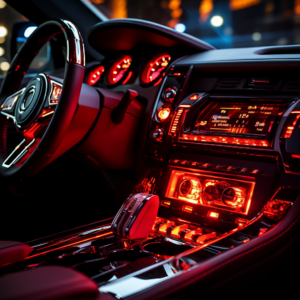Instrument panel backlighting
Instrument panel backlighting in automotive refers to the illumination of the various gauges, indicators, controls, and displays on the vehicle’s instrument cluster. This backlighting serves essential functions, providing visibility and readability for drivers to monitor the vehicle’s performance and receive important information while driving.

Here are the key aspects and purposes of instrument panel backlighting in automotive applications:
1. Visibility and Readability:
Instrument panel backlighting ensures that the information displayed on the instrument cluster is easily visible and readable, regardless of external lighting conditions.
2. Safety and Driver Focus:
Well-designed backlighting enhances driver safety by reducing the need for the driver to strain or adjust their vision to read the instruments. This contributes to driver focus on the road.
3. Consistency:
The backlighting creates a consistent and uniform illumination across the entire instrument cluster, making it easier for the driver to quickly interpret the data presented.
4. Nighttime Driving:
Instrument panel backlighting is especially crucial during nighttime driving when external lighting is limited. It ensures that the information remains clear and legible.
5. Variable Illumination:
Some vehicles offer variable backlighting, allowing the driver to adjust the brightness of the instrument cluster to their preference. This feature is beneficial for drivers who may find lower or higher brightness levels more comfortable.
6. Color Customization:
Modern vehicles often allow drivers to customize the color of instrument panel backlighting to match their preferences or create a specific ambiance in the cabin.
7. Warning Indicators:
Backlit warning indicators, such as check engine lights, turn signals, and seat belt reminders, ensure that these critical alerts are instantly noticeable.
8. Fuel and Speed Readings:
Backlighting for speedometers and fuel gauges ensures that drivers can readily monitor their vehicle’s speed and fuel levels.
9. Engine and Diagnostic Data:
Instrument panel backlighting is used for displaying engine performance data, such as RPM (revolutions per minute), temperature, and oil pressure, allowing drivers to monitor the vehicle’s health.
10. Multimedia and Infotainment Displays:
Many modern instrument clusters include infotainment displays that may feature navigation, audio, and other information, all of which are illuminated for readability.
11. Ambient Lighting Integration:
Some vehicles integrate instrument panel backlighting with the overall cabin ambient lighting, creating a coordinated and harmonious lighting environment.
12. Maintenance and Service Indicators:
Backlit indicators for scheduled maintenance, such as oil change reminders, help drivers stay on top of their vehicle’s service needs.
13. Energy-Efficient Lighting:
Instrument panel backlighting is often achieved using energy-efficient LED technology, providing bright illumination while consuming minimal power.
Instrument panel backlighting is a crucial component of the driver’s interface with the vehicle, ensuring that essential information is readily accessible and easy to understand. Well-designed backlighting contributes to driver safety, comfort, and convenience, and it plays a significant role in enhancing the driving experience, especially during nighttime or low-light conditions.